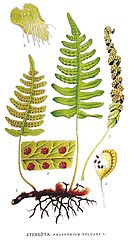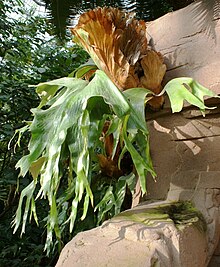Paprotkowate
 Paprotka zwyczajna | |
| Systematyka[1][2] | |
| Domena | eukarionty |
|---|---|
| Królestwo | rośliny |
| Podkrólestwo | rośliny zielone |
| Nadgromada | telomowe |
| Gromada | naczyniowe |
| Klasa | paprocie |
| Podklasa | paprotkowe |
| Rząd | paprotkowce |
| Rodzina | paprotkowate |
| Nazwa systematyczna | |
| Polypodiaceae Bercht. & J.Presl 1820 | |
Paprotkowate (Polypodiaceae Bercht. & J. Presl) – rodzina roślin należąca do klasy paproci. Zalicza się do niej ok. 1000 gatunków, zgrupowanych w 50 rodzajach.
Systematyka
W systemie Smitha i in. (2006) rodzina w rzędzie paprotkowców (Polypodiales)[3]. W systemie PPG I (2016) rodzina w obrębie podrzędu Polypodiineae H.Schneid. & C.J.Rothf. 2016 odpowiadającemu kladowi „eupolypods I” w systemie Smitha i in. (2006)[2].
| paprotkowce |
| ||||||||||||||||||||||||||||||||||||||||||||||||||||||||||||||||||||||||||||||||||||||||||||||||||||||||||||||||||||||||||||||||||||||||||||||||||||||
- Podział rodziny na podrodziny i rodzaje[2]
podrodzina: Loxogrammoideae H.Schneid. in Christenhusz et al., Phytotaxa 19: 18. 2011
- Dictymia J.Sm., Companion Bot. Mag. 72: 16. 1846
- Loxogramme (Blume) C.Presl, Tent. Pterid.: 214–215, pl.9, f.8. 1836
podrodzina: Platycerioideae B.K.Nayar, Taxon 19: 233. 1970
- Platycerium Desv., M_em. Soc. Linn. Paris 6(3): 213. 1827 – płaskla
- Pyrrosia Mirb., Hist. Nat. Veg. 3: 471. 1803 – pyrozja
podrodzina: Drynarioideae Crabbe, Jermy & Mickel, Fern Gaz. 11: 156. 1975
- Drynaria (Bory) J. Sm. (w tym Aglaomorpha Schott, Gen. Fil.: t.19. 1836) – drynaria
- Arthromeris (T.Moore) J.Sm., Hist. Fil.: 110. 1875
- Gymnogrammitis Griff., Icon. Pl. Asiat. 2: t.129, f.1. 1849
- Paraselliguea Hovenkamp, Blumea 45(2): 376. 2000
- Polypodiopteris C.F.Reed, Amer. Fern J. 38: 87. 1948
- Selliguea Bory, Dict. Class. Hist. Nat. 6: 587–588. 1824
podrodzina: Microsoroideae B.K.Nayar, Taxon 19(2): 233. 1970
- Goniophlebium (Blume) C.Presl, Tent. Pterid.: 185, pl.7, f.13–14. 1836
- Lecanopteris Reinw. ex Blume, Enum. Pl. Javae 2: 120. 1828
- Lemmaphyllum C.Presl, Abh. Koenigl. Bohm. Ges. Wiss. Ser. 5 6: 517–518. 1851
- Lepidomicrosorium Ching & K.H.Shing, Bot. Res. Academia Sinica 1(1): 1–14, pl.1–5. 1983
- Lepisorus (J.Sm.) Ching, Bull. Fan Mem. Inst. Biol. Bot. 4(3): 47, 56–58. 1933
- Leptochilus Kaulf., Enum. Filic.: 147, pl.1, f.10. 1824
- Microsorum Link, Hort. Berol. 2: 110. 1833
- Neocheiropteris Christ, Bull. Soc. Bot. France 52 (Mem. 1): 21. 1905
- Neolepisorus Ching, Bull. Fan Mem. Inst. Biol. Bot. 10(1): 11–12. 1940
- Paragramma (Blume) T.Moore, Index Filic. xxxii. 1857
- Thylacopteris Kunze ex J.Sm., Hist. Fil.: 87. 1875
- Tricholepidium Ching, Acta Phytotax. Geobot. 29 (1–5): 41. 1978
podrodzina: Polypodioideae Sweet, Hort. Brit.: 460. 1826.
- Campyloneurum C.Presl, Tent. Pterid.: 189. 1836
- Microgramma C.Presl, Tent. Pterid.: 213. 1836
- Niphidium J.Sm., Hist. Fil.: 99. 1875
- Pecluma M.G.Price, Amer. Fern J. 73(4): 109. 1983
- Phlebodium (R.Br.) J.Sm., J. Bot. (Hooker) 4: 58. 1841 – flebodium
- Pleopeltis Humb. & Bonpl. ex Willd., Sp. Pl., ed. 4, 5: 211. 1810
- Pleurosoriopsis Fomin, Izv. Kievsk. Bot. Sada 11: 8. 1930
- Polypodium L., Sp. Pl. 2: 1082. 1753 – paprotka
- Serpocaulon A.R.Sm., Taxon 55(4): 924–927, f. 3-4. 2006
podrodzina: Grammitidoideae Parris & Sundue, 2016
- Acrosorus Copel., Philipp. J. Sci. 1(Suppl. 2): 158–159. 1906
- Adenophorus Gaudich., Ann. Sci. Nat. (Paris) 3: 508. 1824
- Alansmia M.Kessler, Moguel, Sundue & Labiak, Brittonia 63(2): 238. 2011
- Archigrammitis Parris, Fern Gaz. 19(4): 135–136. 2013
- Ascogrammitis Sundue, Brittonia 62(4): 361. 2010
- Calymmodon C.Presl, Tent. Pterid.: 203–204, pl.9, f.1. 1836
- Ceradenia L.E.Bishop, Amer. Fern J. 78(1): 2. 1988
- Chrysogrammitis Parris, Kew Bull. 3(4): 909. 1998
- Cochlidium Kaulf., Berlin. Jahrb. Pharm. Verbundenen Wiss. 21: 36. 1820
- Ctenopterella Parris, Gard. Bull. Singapore 58(2): 234. 2007
- Dasygrammitis Parris, Gard. Bull. Singapore 58(2): 238. 2007
- Enterosora Baker, Timehri 5: 218. 1886
- Galactodenia Sundue & Labiak, Syst. Bot. 37(2): 340. 2012
- Grammitis Sw., J. Bot. (Schrader) 2: 3, 17. 1801
- Lellingeria A.R.Sm. & R.C.Moran, Amer. Fern J. 81 (3): 76. 1991
- Leucotrichum Labiak, Taxon 59(3): 915. 2010
- Lomaphlebia J.Sm., Hist. Fil.: 182. 1875
- Luisma M.T.Murillo & A.R.Sm., Novon 13(3): 313–316, f. 1. 2003
- Melpomene A.R.Sm. & R.C.Moran, Novon 2(4): 426. 1992
- Micropolypodium Hayata, Bot. Mag. (Tokyo) 42 (449): 341. 1928
- Moranopteris R.Y.Hirai & J.Prado, Taxon 60(4): 1127. 2011
- Mycopteris Sundue, Brittonia 66(2): 175, f.1–2. 2013
- Notogrammitis Parris, New Zealand J. Bot. 50(4): 465. 2012
- Oreogrammitis Copel., Philipp. J. Sci. 12: 64. 1917
- Prosaptia C.Presl, Tent. Pterid.: 165–166, pl.6, f.19, 25. 1836
- Radiogrammitis Parris, Gard. Bull. Singapore 58 (2): 240. 2007
- Scleroglossum Alderw., Bull. Jard. Bot. Buitenzorg, ser. 2, 2(7): 37–39. 1912
- Stenogrammitis Labiak, Brittonia 63(1): 141, f.1A–M, 2A–F. 2011
- Terpsichore A.R.Sm., Novon 3(4): 479. 1993
- Themelium (T.Moore) Parris, Kew Bull. 52(3): 737. 1997
- Tomophyllum (E.Fourn.) Parris, Gard. Bull. Singapore 58(2): 245. 2007
- Xiphopterella Parris, Gard. Bull. Singapore 58(2): 249. 2007
- Zygophlebia L.E.Bishop, Amer. Fern J. 79(3): 107. 1989
Rodzaj o niejasnej pozycji systematycznej:
- Synammia C.Presl, Tent. Pterid.: 212, t.9, f.11. 1836
Przypisy
- ↑ Michael A. Ruggiero i inni, A Higher Level Classification of All Living Organisms, „PLOS ONE”, 10 (4), 2015, e0119248, DOI: 10.1371/journal.pone.0119248, PMID: 25923521, PMCID: PMC4418965 [dostęp 2021-02-28] (ang.).
- ↑ a b c d The Pteridophyte Phylogeny Group. A community-derived classification for extant lycophytes and ferns. „Journal of Systematics and Evolution”. 54 (6), s. 563–603, 2016. DOI: 10.1111/jse.12229.
- ↑ Smith, A. R., K. M. Pryer, E. Schuettpelz, P. Korall, H. Schneider & P. G. Wolf. A classification for extant ferns. „Taxon”. 55 (3), s. 705–731, 2006 (ang.).
- ↑ Samuli Lehtonen. Towards Resolving the Complete Fern Tree of Life. „PLoS ONE”. 6, 10, s. e24851, 2011. DOI: 10.1371/journal.pone.0024851.
- ↑ Carl J. Rothfels, Anders Larsson, Li-Yaung Kuo, Petra Korall, Wen- Liang Chiou, Kathleen M. Pryer. Overcoming Deep Roots, Fast Rates, and Short Internodes to Resolve the Ancient Rapid Radiation of Eupolypod II Ferns. „Systematic Biology”. 61, 1, s. 70, 2012.
Media użyte na tej stronie
Autor: (of code) -xfi-, Licencja: CC BY-SA 3.0
The Wikispecies logo created by Zephram Stark based on a concept design by Jeremykemp.
Autor: Krzysztof Ziarnek, Kenraiz, Licencja: CC BY-SA 4.0
Microgramma lycopodioides in the Botanischer Garten, Berlin-Dahlem
Autor: Krzysztof Ziarnek, Kenraiz, Licencja: CC BY-SA 4.0
Pyrrosia eleagnifolia in Eastwoodhill Arboretum (New Zealand)
Autor: Anatoly Mikhaltsov, Licencja: CC BY-SA 4.0
Fern Polypodium aureum Sorus
Sorus length: 2 mm Sorus is composed of many sporangia that contain spores. You can see rings similar to worms. There are numerous frond stomata around the sorus. Light microscopy, incident light
Total magnification – 50x, focus stacking - 166 images








